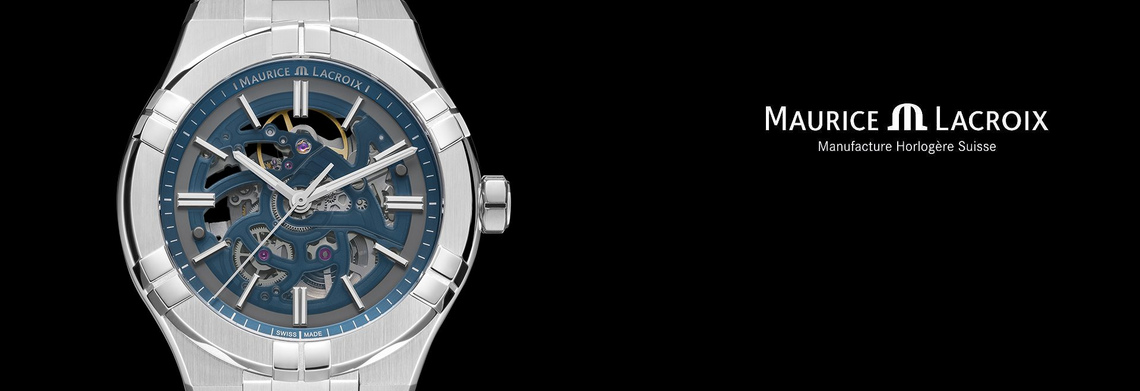

Maurice Lacroix: a quarter of a century for Masterpiece…
This year, the Masterpiece collection by Maurice Lacroix is celebrating 25 years of its love for fine mechanical watches. Watchonista profiles the historic brand.
The Maurice Lacroix Manufacture, founded in 1975 at Saignelégier in the Swiss canton of Jura by the Desco von Schulthess group, specialised for a while in the manufacture of private label third party timepieces, before producing timekeepers under its own name. In 1989, the company acquired the case maker, Queloz SA, also based in Saignelégier. With a certain understsanding of the changes taking place in the industry, Maurice Lacroix seized upon the economic climate and rising demand in watchmaking production for its 1990 launch of the high-end Les Mécaniques line, renamed the Masterpieces two years later. Success was not long in coming and the 1992 Cinq Aiguilles watch, in particular, was a resounding triumph. This mechanical reference, boasting a classic design totally in keeping with the times, displayed the hours, minutes and seconds, not to mention the date and day of the week, via hands placed in the centre of the dial.
Focus on useful complications
Aware of the potential represented by mechnical watchmaking, still a relatively new concept in the businessman's mind, the brand, in 1999, unveiled its Flyback Annuaire chronograph, a highly complicated instrument for its time, fitted with calibre ML15 for displaying the time, recording short time intervals, and boasting a flyback, yearly calendar and large date feature. That same year, the House also launched the Masterpiece Retrograde Calendar, which, as its name suggests, sports a retrograde display, as well as a power reserve indicator based on an inovative differential.
In 2002, Maurice Lacroix pushed the goalposts a little further back by producing the Masterpiece Réveil Globe watch, which will remain forever etched in our memories as a model custom-built for the intrepid adventurer at a time when smartphones were a mere figment of our imaginations. That same year, it also produced the Masterpiece Chrono Globe. Upon its launch in 2003, the brand also planned to roll out the exhilirating, and now somewhat rare, Masterpiece Phases de Lune Tonneau complete with steel case, whose sober and highly refined design had been for a very long time in the making. That very year, the brand also rolled out the Masterpiece Double retrograde with a complication bottom-plate produced entirely in-house.
The idea took hold, in-house development escalated and, in 2005, Maurice Lacroix presented the Masterpiece Moon Retrograde, whose calibre ML 104 housed a three-quarters original bottom plate, which marked the start of a brand new industrial adventure.
The era of the in-house calibre
The year 2006 marked the turning point for Maurice Lacroix with the manufacture's launch of its first in-house calibre, the now famous chronograph ML106 with manual winding. With this attention-grabbing instrument, the brand soon achieved major recognition and rose to the highest level among renowned Swiss entities. Having established a reputation for its base movement, the house went on to produce the Roue Carrée in 2010, whose seconds display was replaced by two non-circular geometric rotary cogs. The meshing together between the two is a feat of magic that defies all human understanding.
In the same spirit of wonderment and to carry the magic metaphor further, the company, in 2013, brought out the Masterpiece Mysterious Second, a reference powered by the calibre ML215 generously openworked for the occasion (a house speciality largely used for intermediate pieces). Among other features, this model boasted a seconds display that appeared to levitate randomly and unassisted within a broad disc. In reality, the mechanism powering the disc is largely inspired by the non-linear wheels employed in the previous version of the Masterpiece.
Prior to the launch of Gravity in 2014, Maurice Lacroix introduced a fresh style by devising a brand new type of calibre powered by components made for the first time in silicium. This avant-garde technology, still in little use at that time, marked a decisive turning point for the company with its capacity to develop these cutting-edge elements in-house. Twenty-five years ago, the manufacture had set its sights on achieving independent status, it went on to prove that, although diminutive in size, it could start innovating and competing daily with the biggest, most powerful names in watchmaking.
Taking great pride in its mechanical and graphical approach to the art of time-measurement, the company chose in 2017 to revisit its past by celebrating the unique craftsmanship apparent in two major pieces in the brand's history: the Masterpiece Double Retrograde and the Masterpiece Moon Retrograde. Both these watches symbolise a kind of golden age, one that the manufacture intends to embrace once again with the integration of complicated, solid, efficient and appropriately priced watchmaking products.







